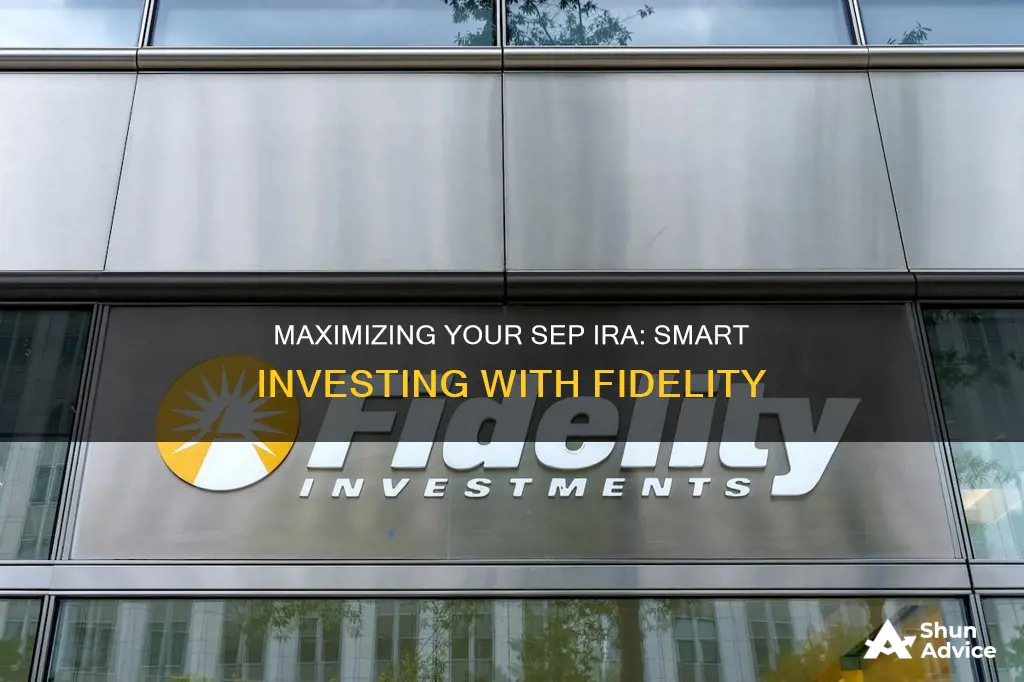
If you're self-employed or a small business owner, a Simplified Employee Pension (SEP) IRA can be a powerful retirement savings vehicle. It lets you, as the employer, defer taxes on contributions and any investment growth in the account. SEP IRAs are available to businesses of all sizes but are best suited to self-employed individuals, small business owners, or members of a partnership. They have low costs and are simple to administer, with minimal start-up costs or annual fees.
If you're interested in opening a SEP IRA with Fidelity, here's an overview of what you need to know.
| Characteristics | Values |
|---|---|
| Who is it for? | Self-employed individuals, small business owners, or members of a partnership |
| Type of account | Simplified Employee Pension plan (SEP IRA) |
| Investment options | Mutual funds, stocks, bonds, ETFs, and more |
| Annual contribution limit | 25% of compensation, up to $69,000 for 2024 |
| Maximum compensation for contributions | $345,000 for 2024 |
| Individual contribution limit | $7,000 for tax year 2024 ($8,000 if over age 50) |
| Deadlines | By the due date of the sponsoring business's income tax return for that year, with extensions if applicable |
| Eligibility requirements | Employed full-time for any period during at least 3 of the last 5 years; earned at least $750 in compensation from the SEP IRA-sponsoring employer in 2024 |
| Vesting | Employees are fully vested as soon as money is contributed to the account |
| Withdrawals | 10% early withdrawal penalty may apply for withdrawals before age 59 1/2; penalty-free withdrawals for qualifying first-time home purchases and certain college expenses |
| Loans | Not allowed |
| Rollovers | Allowed from/to other qualifying IRAs, such as traditional IRAs |
| Tax advantages | Earnings are tax-deferred and contributions are tax-deductible |
| Administrative fees | No setup or administration fee; annual custodial fee deducted from employee accounts |
What You'll Learn

How to set up a SEP IRA
Setting up a Simplified Employee Pension (SEP) Individual Retirement Account (IRA) is a relatively straightforward process. Here's a step-by-step guide on how to set up a SEP IRA:
- Choose a Provider: Select a financial institution that offers SEP IRAs, such as Fidelity or Charles Schwab.
- Determine Eligibility: Verify that you meet the eligibility requirements for a SEP IRA. SEP IRAs are typically designed for self-employed individuals, small business owners, or members of a partnership.
- Complete the Required Forms: Fill out the necessary forms to establish your SEP IRA plan and account. This may include an Employer's Agreement, Adoption Agreement, and other relevant documents.
- Enroll Employees: If you have employees, provide them with the necessary information and forms to open their own SEP IRA accounts. Each eligible employee must establish their own account.
- Set Up Contributions: Decide on the contribution amount and frequency. Contributions can be made until the employer's tax-filing deadline, including any extensions. Contributions are typically made by the employer and can vary between 0% and 25% of compensation, with a maximum of $69,000 for 2024.
- Administer the Plan: SEP IRAs are easy to administer and have minimal tax-filing requirements. However, employers must maintain records of the plan agreement and provide written agreements to employees outlining the details of the plan.
- Invest the Funds: Once the employer contribution is made, you and your employees can choose from a wide range of investment options offered by the account provider, such as mutual funds, stocks, bonds, or exchange-traded funds (ETFs).
Remember to consult with a tax or financial advisor to ensure that a SEP IRA is suitable for your specific circumstances and to stay compliant with any applicable laws and regulations.
The S&P 500 Index Fund: Your Easy Investing Guide
You may want to see also

How to make contributions to a SEP IRA
To make contributions to a SEP IRA, you must first establish your plan. This involves filling out and retaining Form 5305 SEP by your business' tax-filing deadline (including extensions, if filed). Each eligible employee must then open a SEP IRA account. It is important to note that SEP IRA accounts are in the name of the participating employee only, so if you are the employer, you must obtain the account number and institution where the account is held from your employee to contribute on their behalf.
Once your plan is established, you need to notify your employees of the employer's contribution and contribute to their accounts. The deadline for this is your business' tax-filing deadline plus extensions. Contributions must be made by the employer and can vary each year between 0% and 25% of compensation, with a maximum of $66,000 for 2023 and $69,000 for 2024. Each eligible employee must receive the same percentage.
There are several methods for contributing to a SEP IRA account, depending on the business structure. These include mobile check deposit through the Fidelity mobile app, electronic funds transfer (ETF) from a personal bank account, on Fidelity.com from an individual account, by BillPay from a business bank account, by phone through a representative, or by wire transfer.
It is important to note that you can contribute to both a SEP IRA and either a traditional IRA or Roth IRA in the same year, as long as you meet the income limit requirements. However, the deductibility of traditional IRA contributions may be impacted by the SEP IRA contribution.
Vanguard Dividend Growth Fund: A Comprehensive Investment Guide
You may want to see also

How to transfer existing SEP IRA accounts to Fidelity
Download a digital statement from your current firm:
Before initiating the transfer, download a digital statement from your current firm. This will allow you to refer to important account information during the transfer process. You may need to upload a copy of this statement to complete the transfer.
Open a compatible account with Fidelity:
If you don't already have an account with Fidelity, you will need to open one. You can choose to transfer your SEP IRA into a Fidelity SEP IRA, Rollover IRA, or Traditional IRA. The process of opening an account with Fidelity is quick and easy, and can be completed online.
Initiate the transfer:
You can initiate the transfer process online through the "Transfer an Account to Fidelity" page on the Fidelity website. This is typically referred to as a Transfer of Assets (TOA). During the transfer process, you may be given the opportunity to open a compatible account if you haven't already done so.
Submit the transfer request:
Submit your transfer request to Fidelity, who will then contact your current firm and request the account assets. After your current firm processes the request, they will send the account assets to Fidelity, who will deposit them into your selected account.
Track the status of the transfer:
You can track the progress of your transfer online at any time using the Status Tracker tool on the Fidelity website. Most transfers take 3-5 business days to complete, but some may take longer.
Be aware of potential fees:
Fidelity does not charge any transfer fees for receiving assets. However, your current firm may charge fees for transferring your assets to Fidelity. It is important to follow up with your current firm to be aware of any applicable transfer fees.
Mutual Fund Profits: Where to Invest and Why
You may want to see also

How to roll over old workplace retirement accounts to Fidelity
Rolling over an old workplace retirement account into a Fidelity IRA is a multi-step process. Here's a detailed guide on how to do it:
Step 1: Open a Fidelity IRA
You can open a Fidelity IRA online. Note that if you want to preserve all options to roll your money into another retirement plan in the future, it may be more appropriate to roll the assets into a Rollover IRA that will not receive contributions.
Step 2: Contact your old retirement plan provider
If your old retirement plan is with Fidelity, you can do the entire rollover through your NetBenefits® account. You won't need any additional paperwork, and the money can be directly transferred.
If your old retirement plan is with a different provider, they will need to start the rollover process. You'll need to contact them either by phone or online. They may require some paperwork, such as a Letter of Acceptance (LOA) from Fidelity, or their own paperwork completed and signed by you or a Fidelity representative. If you have multiple accounts or employers, you may need more than one LOA.
Step 3: Deposit your money into your Fidelity account
You can have the rollover check sent directly to Fidelity to deposit into your account, or you can deposit it yourself. Here are the ways to roll over funds to Fidelity:
- Wire directly: When sending a direct rollover from an employer plan to a retirement account, include code DRC.
- Mobile check deposit: Use the Fidelity Investments app for your mobile check deposit.
- Regular mail: Send to Fidelity Management Trust Company, PO Box 770001, Cincinnati, OH 45277-0037.
- Overnight mail: Send to Fidelity Management Trust Company, 100 Crosby Parkway KC1H, Covington, KY 41015-0037
- Bring to a Fidelity Investor Center: Find an investor center near you.
Please note: If a rollover check is made payable directly to you, you must deposit the money into your IRA within 60 days of receiving the check to avoid income taxes and a possible early withdrawal penalty.
Step 4: Invest your money
Once your money is in your IRA, you'll need to invest it. This is a crucial step, as investing is how your money has the potential to grow over time. You can choose to invest in a wide range of investment options, including mutual funds, stocks, bonds, ETFs, and more.
Closed-End Investment Funds: Where and How to Trade
You may want to see also

How to choose your own investments
Once you have set up your SEP IRA, you can choose to manage your own portfolio. Fidelity offers a range of investment options to choose from, including:
- Mutual funds
- Stocks
- Bonds
- ETFs
- CDs
You can use Fidelity's free planning tools to manage your own portfolio. There is no minimum amount required to open an account, and you can invest with as little as $10 or $11, depending on the type of account.
If you are unsure about which investments to choose, you can use Fidelity's Planning and Guidance Centre to create and monitor multiple independent financial goals. You can also work with a Fidelity advisor or consider Fidelity Wealth Services for planning and investment management.
It is important to remember that investing involves risk, and the value of your investments may fluctuate. It is recommended that you consult with a financial professional before making any investment decisions.
A Guide to Investing in Birla Sunlife Mutual Funds
You may want to see also
Frequently asked questions
A Simplified Employee Pension (SEP) IRA is a retirement savings vehicle for self-employed individuals or small-business owners. It allows employers to defer taxes on contributions and any investment growth in the account.
You can set up a SEP IRA with most financial institutions that offer retirement accounts. You will need to fill out and retain Form 5305 SEP.
The contribution limit for a SEP IRA is 25% of an employee's total compensation, up to $69,000 for the 2024 tax year.
Yes, you can contribute to other retirement accounts in addition to your SEP IRA.
Yes, you can roll over funds from a SEP IRA into other qualifying IRAs, such as traditional IRAs. You can also convert SEP IRA funds into a Roth IRA, but this may require paying taxes on the money you convert.







